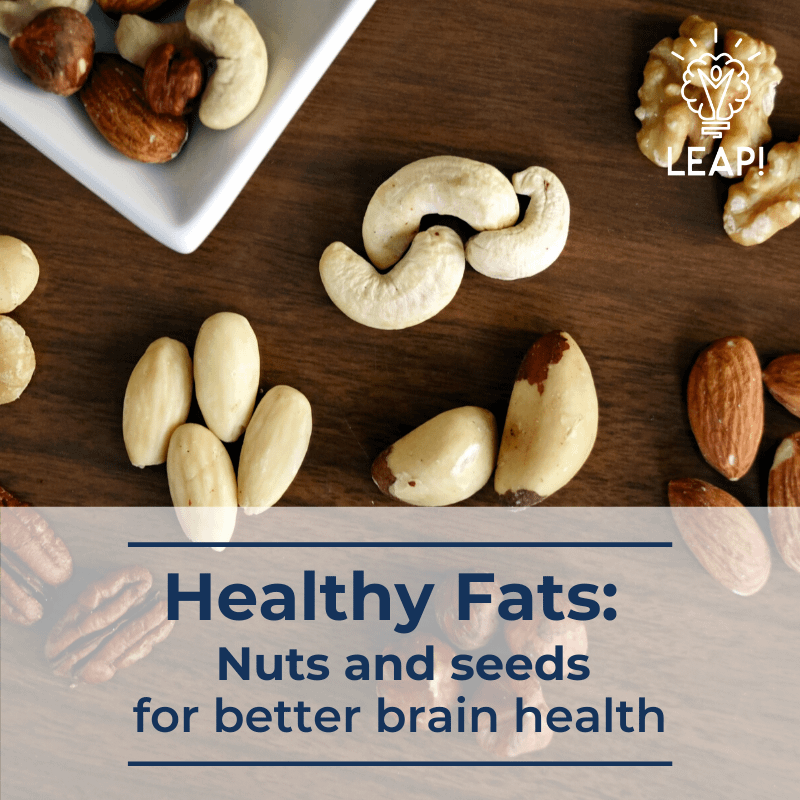You read our last post which detailed the benefits of extra virgin olive oil—its importance to the Mediterranean eating pattern, its high levels of nourishing fats, and its antioxidant properties. But did you know that nuts and seeds are also excellent sources of healthy fats?
They’re an important part of the Mediterranean diet, too!
One of the most common questions we get is “Which nuts are healthy?” That’s why we’re here to give you the details on different types of nuts, explain how and why they’re beneficial for brain health, and provide some helpful tips for how to increase your intake.
Nuts are extremely nutrient dense, containing unsaturated fats, high quality vegetable protein, fiber, minerals such as calcium and potassium, and antioxidant compounds such as tocopherols and phytosterols¹.
Together, these nutrients give nuts and seeds their power to help reduce risk of diseases such as heart disease, diabetes, and obesity, which can all be considered as risk factors for Alzheimer’s.
By definition, tree nuts are dry fruits with one seed in which the fruit wall becomes hard at maturity. The most common nuts include almonds, walnuts, cashews, pistachios, hazelnuts, Brazil nuts, pecans, pine nuts, and macadamias¹. Peanuts, although technically a legume, are also considered by consumers as a type of nut.
This diverse line-up of types of nuts gives us plenty to choose from for healthy snacking.
But are some nuts healthier than others?
Not necessarily. Although each type of nut has a unique composition of unsaturated fats, protein, and other nutrients, this doesn’t mean that one type is always better than the others. What’s most important is that we consume a variety.
Nuts help with satiety, or feelings of fullness after eating. This is due to their high caloric, fiber, and protein content which makes nuts take longer to digest and keeps you feeling satisfied, for longer.
Despite being high in calories, though, multiple studies have shown that the consumption of nuts is unlikely to lead to weight gain².
Here’s a closer look at some of our favorite types of nuts and their unique qualities.
Almonds
Almonds are not only one of the most popular nuts, but also one of the most widely studied varieties.
Clinical trials suggest that almonds can help control blood sugar and improve levels of HDL cholesterol². In one study, the intake of 100 grams of almonds in combination with cholesterol-lowering medications helped lower non-HDL cholesterol³.
Almonds are also particularly rich sources of vitamin E and magnesium, two important nutrients that many average Americans may be deficient in². These compounds are what help give almonds its antioxidant properties and its heart-healthy qualities—both of which contribute to our brain health.
Walnuts
Walnuts are unique because they have more polyphenols than other nuts and also have a notably high content of alpha-linolenic acid (ALA), a type of polyunsaturated fatty acid (PUFA)⁴.
Being a polyunsaturated fat, ALA is considered an essential nutrient—our bodies do not make it naturally, so we need to get it through our diet. Walnuts are one of the foods richest in this anti-inflammatory, neuroprotective healthy fat⁴.
Additionally, the polyphenols in walnuts help reduce oxidative stress, protect against cancer, and may even promote healthy gut bacteria, according to new research⁴.
Cashews
Cashews are one of the most widely produced type of nut, though research on their health effects is limited.
There are common questions about the health profile of cashews—they’re higher in carbohydrates and have one of the lowest levels of fiber when compared to other nuts—but cashews are rich in monounsaturated fatty acids (MUFAs), which may help protect against heart disease².
Cashews are also high in vitamin E, which helps reduce oxidative stress, promotes immune function, and benefits the eyes and skin¹³.
Pistachios
Pistachio consumption may help reduce fasting glucose level, lower LDL cholesterol, and improve HDL cholesterol². In one 2015 study, regular consumption of pistachios by adults with mild cholesterol issues, in combination with exercise, helped reduce LDL concentrations and improve HDL levels⁵.
Pistachios are one of the nuts richest in protein and the richest nut in fiber, making them very filling⁶. Additionally, pistachios have the highest content of phytosterols, which helps regulate cholesterol levels⁶.
Peanuts
Peanuts are technically legumes, not nuts, but they are nutritionally similar to nuts in many ways. Peanuts are the highest in protein and contain all 20 essential amino acids⁷. They’re also high in resveratrol, an antioxidant compound that may help protect against cancer and heart disease⁷. Additionally, resveratrol has been shown to help increase blood flow to the brain, which helps reduce the risk of stroke⁷.
Peanuts are cheap and widely available, especially in peanut butter. While peanuts are nutritious, don’t forget to make sure you’re balancing your peanut intake with other types of nuts and seeds.
If you use peanut butter, make sure you purchase natural peanut butter with no hydrogenated or partially hydrogenated oils (trans fats!) and no added sugar. Oil-on-top peanut butters are the best option, but they require stirring and refrigeration (to prevent the oil from re-separating). One way to make this easier is to store the jar upside down for a couple days before you open it for the first time. This helps the oil soak back in before you stir it.
Pumpkin Seeds
Pumpkin seeds are an excellent source of protein, fiber, omega-6 fatty acids and carotenoids—plant compounds that help the immune system, protect the eyes and skin, and help reduce the risk of heart disease⁸. Diets rich in pumpkin seeds have also been associated with a reduced risk in certain types of cancer⁸.
What are some ways you can eat pumpkin seeds?
We like these ideas from the MyFitnessPal blog.
Eating Well also has some recipes for every taste bud palette.
Like nuts, seeds are also most beneficial when closest to their raw, natural form.
Chia Seeds
Chia seeds are small but packed with nutritive compounds. Chia seeds have more fiber than any nut, are high in omega-3 fatty acids, and contain polyphenols⁹.
One study found that supplementation of chia seeds in the diet can help type 2 diabetics control their blood glucose. Researchers theorize the moderate sugar-lowering effect of chia seeds is due to their high fiber content, which forms a gel-like substance in the body that may help reduce the amount of sugar released by fiber¹⁰.
For those who follow plant-based diets, a combination of ground chia seeds and water can be used to substitute eggs. We like this simple method from Detoxinista for “chia eggs” or “flax eggs.”
Other ways to integrate chia seeds into your diet include adding it to yogurt, oatmeal, or even to a salad!
Check out this blog post from Eating Bird Food for more fun ways to eat chia seeds.
Flax Seeds
Flax seeds are another great source of anti-inflammatory omega 3’s, as well as a special type of fiber called lignan, which may help control blood sugar, lower blood pressure, and reduce oxidative stress¹¹. In fact, flax seeds have more lignans than any other plant-based source (nuts, beans, certain vegetables).
Unlike other nuts and seeds, flax seeds must be ground before you eat them. Flaxseed meal is widely available, but we do not recommend purchasing it. Instead, buy your flax seeds whole and raw, store them in the fridge or freezer, and grind them just before use.
You can quickly grind flax seeds in a (clean!) coffee grinder or a high-speed blender. We recommend grinding about a week’s worth at a time and freezing the grounds you don’t use the same day.
Why is this so important? Although flax seeds are a great source of anti-inflammatory omega-3 fats, these compounds break down very quickly when exposed to oxygen (some say as quickly as 24 hours!).
Similar to chia seeds, ground flax seeds can be sprinkled into smoothies, oatmeal, or yogurt—but flax seeds can also be used in savory dishes for lunch or dinner!
This post from Cooking Light gives you 15 unique ways to cook with flax seed, for any type of craving!
Tips for purchasing, storing, and consuming nuts and seeds
- Try to purchase nuts and seeds raw, preferably unsalted or lightly salted. Some varieties of roasted nuts can be high in sodium and coated in vegetable oils, so be sure to check the label for additional information! Additionally, the high heat used in roasting can damage some of the healthy fats. We recommend buying raw and roasting at home for optimum freshness. Roast in the oven at 300 °F for 5 to 20 minutes, depending on the nut. Typically, small nuts or seeds need a shorter amount of time.
- The freshness and nutritional compounds of nuts can be affected by heat, light, and oxygen. To keep nuts and seeds from going rancid, store them in the fridge or freezer in an airtight container or sealed package.
- Get a variety. Each type of nut or seed has different levels of different nutrients—make sure you get as much of a variety as you can to reap the most benefits!
- Aim for at least 2 servings of nuts and seeds per week. Remember that a serving is about 1 ounce or ¼ cup (that’s about a small handful).
- Should you soak your nuts? Soaking beans improves their digestibility and makes the nutrients more readily available to our bodies. You may have seen the same thing recommended for nuts. However, there is very little research on the topic of soaking nuts. What little research is available suggests that soaking makes little to no difference. In fact, it may even decrease their mineral content¹². So, unless you are trying to make a dish that requires soft nuts, we don’t recommend soaking them. Keep soaking your beans, though!
In conclusion, nuts and seeds offer more than just healthy fats, and they can be an incredibly brain-healthy snack. Aside from being widely available, they are versatile and convenient—even for the busy-scheduled days. We hope this post gave you some new information about nuts and seeds that you didn’t know before, and encourage you to try new varieties of this nutrient-dense staple!
References
- Ros, E. Health benefits of nut consumption. 2010. Nutrients, 2(7), pp. 652-682. doi: 10.3390/nu2070652
- Machado de Souza, R.G., Mota, J.F., Pimentel, G., & Schincaglia, R.M. Nuts and human health outcomes: A systematic review. 2017. Nutrients, 9(12), 1311. doi: 10.3390/nu9121311
- Ruisinger, J.F. et al. Statins and almonds to lower lipoproteins (the STALL study). 2015. Journal of clinical lipidology, 9(1), pp. 58-64. doi: 10.1016/j.jacl.2014.10.001
- Ros, E., Izquierdo-Pulido, M., & Sala-Vila, A. Beneficial effects of walnut consumption on human health. 2018. Current opinion in clinical nutrition & metabolic care, 21(6), pp. 498-504. doi: 10.1097/MCO.0000000000000508
- Kasliwal, R.R. et al. Effect of pistachio nut consumption on endothelial function and arterial stiffness. 2015. Nutrition, 31(5), pp. 678-685. doi: 10.1016/j.nut.2014.10.019
- Hernandez-Alonso, P., Bullo, M., & Salas-Salvado, J. Pistachios for health. 2016. Nutrition today, 51(3), pp. 133-138. doi: 10.1097/NT.0000000000000160
- Arya, S.S., Salve, A.R., & Chauhan, S. Peanuts as functional food: A review. 2015. Journal of food science technology, 53(1), pp. 31-41. doi: 10.1007/s13197-015-2007-9
- Hussain Dar, A. Sofi, S.A., & Rafiq, S. Pumpkin the functional and therapeutic ingredient: A review. 2017. International journal of food science and nutrition. Retrieved from https://bit.ly/2x3RDxR
- Kulczynski, B., Kobus-Cisowska, J., Taczanowski, M., Kmiecik, D., & Gramza-Michalowska, A. The chemical composition and nutritional value of chia seeds—Current state of knowledge. 2019. Nutrients, 11(6), 1242. doi: 10.3390/nu11061242
- 10. Vuksan, V. et al. Supplementation of conventional therapy with the novel grain salba (Salvia Hispanica L.) improves major and emerging cardiovascular risk factors in type 2 diabetes. 2007. Diabetes care, 30(11), pp. 2804-2810. doi: 10.2337/dc07-1144
- Imran, M. et al. Potential protective properties of flax lignan secoisolariciresinol diglucoside. 2015. Nutrition Journal, 14(71). doi: 10.1186/s12937-015-0059–3
- Kumari, S. et al. Does ‘activating’ nuts affect nutrient bioavailability? 2020. Food chemistry, 319. doi: 10.1016/j.foodchem.2020.126529
- Vitamin E fact sheet. National institutes of health. Office of dietary supplements. 2020. Retrieved from https://ods.od.nih.gov/factsheets/VitaminE-HealthProfessional/



